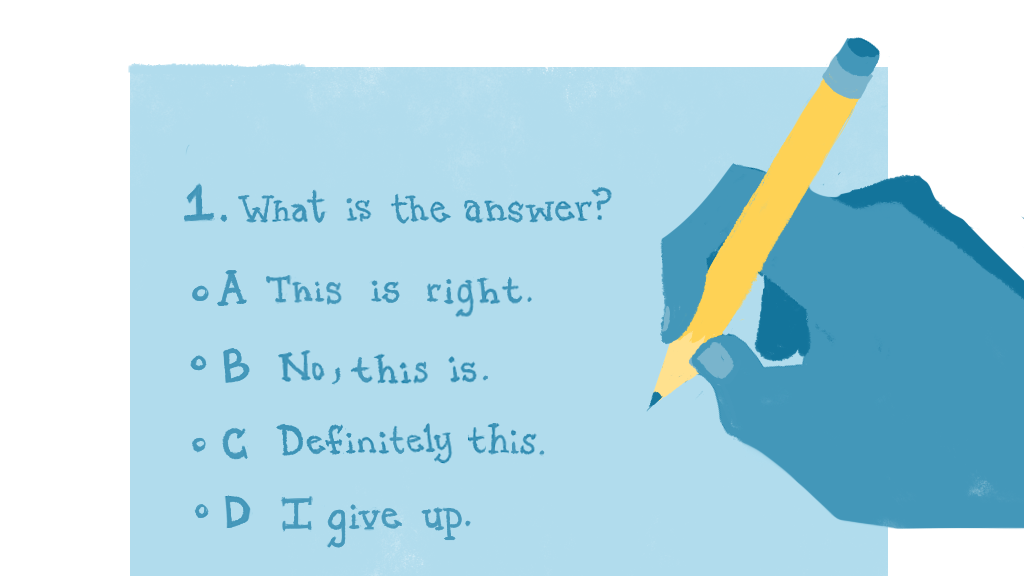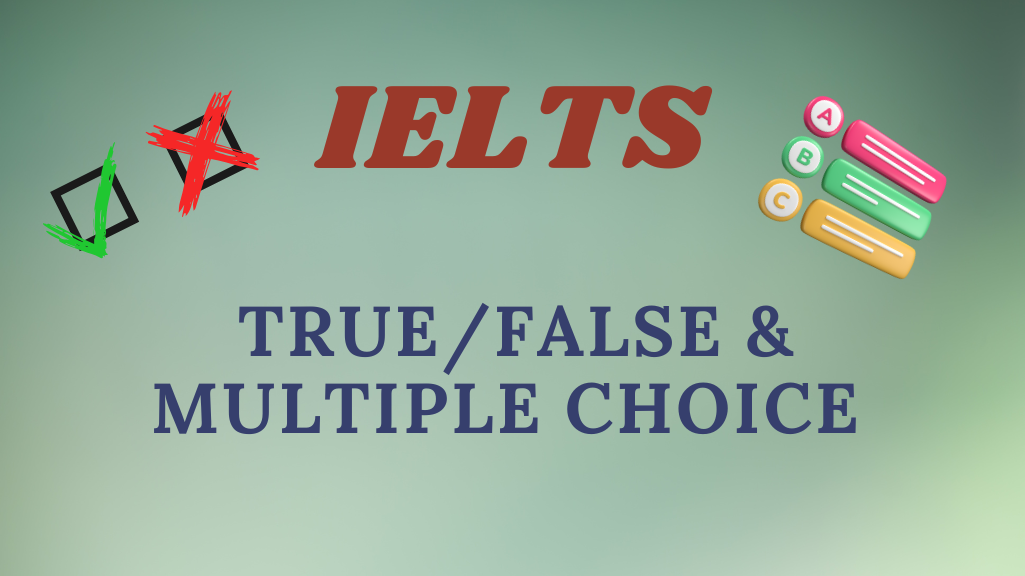This article will cover your basic understanding of True/False/Not Given and Multiple Choice of IELTS reading section and how they are formed with related example so that you can have proper understanding on both of them.
True/False/Not Given Questions in IELTS Reading
One of the most challenging question types in the IELTS Reading section is True/False/Not Given. Many test takers struggle with distinguishing between "False" and "Not Given" because it requires careful reading and strong analytical skills. This section breaks down the strategy needed to excel in this question type.
What Do These Terms Mean?
TRUE: The statement agrees with the information given in the passage.
FALSE: The statement contradicts the information in the passage.
NOT GIVEN: The statement is not mentioned or there is insufficient information to determine whether it is true or false.

Steps to Answer True/False/Not Given Questions
Step 1: Read the Statement Carefully
Before looking at the passage, underline the key information in the given statement. These key elements could include names, numbers, places, or descriptive words that define the meaning of the sentence.
Example statement: "Marie Curie’s husband was a joint winner of both her Nobel Prizes."
Keywords: Marie Curie, husband, joint winner, both Nobel Prizes
Step 2: Scan the Passage for Key Words or Synonyms
IELTS passages rarely use the exact words from the question. Instead, they use synonyms or paraphrased information. Look for similar terms or phrases that might relate to the key words in the statement.
Example Extract: "Marie Curie was twice a winner of the Nobel Prize. With her husband, Pierre Curie, and Henri Becquerel, she was awarded the 1903 Nobel Prize for Physics. She was then the sole winner of the 1911 Nobel Prize for Chemistry."
Step 3: Determine the Answer
TRUE: If the passage confirms the statement exactly.
FALSE: If the passage says something contradictory (e.g., Marie was the sole winner of the second prize, so Pierre was NOT a joint winner of both prizes).
NOT GIVEN: If there is no mention of a relevant fact (e.g., if the passage never mentioned whether Marie was interested in science as a child, we cannot assume it is true).
Common Mistakes to Avoid
Assuming information: Do not rely on what you know outside the passage.
Overthinking "Not Given" statements: If the passage lacks the required information, choose "Not Given" instead of making assumptions.
Ignoring synonyms: IELTS often paraphrases ideas, so be flexible in identifying matching information.
Example of TFNG
Passage: Self-Driving Cars
The development of self-driving cars has accelerated in the past decade, thanks to advances in artificial intelligence and sensor technology. These vehicles use a combination of cameras, radar, and LiDAR to detect their surroundings and navigate roads safely. While many companies, including Tesla, Waymo, and General Motors, are investing heavily in autonomous vehicle technology, widespread adoption is still limited due to regulatory and safety concerns.
Most self-driving cars currently operate in controlled environments or specific urban areas with well-mapped roads. However, researchers are working on improving their ability to handle unpredictable scenarios, such as heavy rain, construction zones, or pedestrians suddenly crossing the street.
A recent study found that fully autonomous vehicles could significantly reduce traffic accidents caused by human error, which accounts for over 90% of road accidents worldwide. Nevertheless, critics argue that self-driving technology is not yet foolproof and may introduce new risks, such as software failures or hacking threats.
TRUE/FALSE/NOT GIVEN Questions
1. Self-driving cars rely on multiple technologies to navigate.
TRUE
The first paragraph states:
"These vehicles use a combination of cameras, radar, and LiDAR to detect their surroundings and navigate roads safely."
This confirms that self-driving cars do rely on multiple technologies for navigation, so the statement is true.
2. All self-driving cars can operate in any environment.
FALSE
The second paragraph mentions:
"Most self-driving cars currently operate in controlled environments or specific urban areas with well-mapped roads."
Since self-driving cars do not operate in every environment but rather in controlled areas, this statement contradicts the passage and is false.
3. Self-driving cars have already eliminated human-caused accidents.
NOT GIVEN
The third paragraph states that self-driving cars could reduce traffic accidents caused by human error but does not claim that they have already eliminated them. Since there is no direct information about whether human-caused accidents have been eliminated, the answer is not given.

Multiple-Choice Questions in IELTS Reading
Multiple-choice questions (MCQs) in IELTS Reading test your ability to identify specific details, opinions, or the main idea of a passage. They require careful reading and elimination techniques.
Types of Multiple-Choice Questions
Single-answer questions: Choose one correct answer from four options (A, B, C, D).
Multiple-answer questions: Select two or more correct answers based on the question requirement.
Steps to Answer Multiple-Choice Questions
Step 1: Read the Question and Identify Keywords
Example: What was the primary reason Marie Curie moved to Paris?
Keywords: primary reason, Marie Curie, moved to Paris
Step 2: Scan the Passage for Relevant Information
Look for sentences that discuss why Marie Curie moved to Paris. The passage may mention multiple reasons, but the question asks for the "primary" one.
Step 3: Use the Process of Elimination
Cross out answers that are incorrect or misleading. If two options seem similar, reread the passage and find the most accurate one.
Example of MCQs
Passage: Renewable Energy
Renewable energy sources, such as solar, wind, and hydroelectric power, have gained significant attention in recent years due to concerns about climate change and fossil fuel depletion. Solar energy, in particular, has seen a dramatic increase in global installations, with countries like China, the U.S., and Germany leading the way.
Wind energy is another major contributor to renewable power, with offshore wind farms becoming more common due to their higher efficiency compared to onshore farms. Hydroelectric power, which has been used for decades, remains the largest source of renewable electricity, but environmental concerns related to dam construction have led to debates about its sustainability.
Despite the advantages of renewable energy, challenges remain. Solar and wind power generation depend on weather conditions, making energy storage crucial for ensuring a reliable power supply. Additionally, the high initial cost of infrastructure and limited availability of certain materials used in solar panels and batteries present obstacles to large-scale adoption.
Multiple-Choice Questions
1. According to the passage, which of the following countries is a leader in solar energy adoption?
A) China
B) India
C) France
D) Brazil
Correct answer: A) China
Explanation: The passage states:
"Solar energy, in particular, has seen a dramatic increase in global installations, with countries like China, the U.S., and Germany leading the way."
Since China is explicitly mentioned, it is the correct answer.
2. Why are offshore wind farms considered more efficient than onshore wind farms?
A) They are easier to maintain
B) They produce more electricity due to stronger winds
C) They require less space
D) They do not affect marine life
Correct answer: B) They produce more electricity due to stronger winds
Explanation: The passage states:
"Wind energy is another major contributor to renewable power, with offshore wind farms becoming more common due to their higher efficiency compared to onshore farms."
Offshore farms are more efficient because of stronger winds at sea, making B the correct choice.
3. What is one challenge of renewable energy mentioned in the passage?
A) It is more expensive than fossil fuels in the long run
B) It causes more pollution than fossil fuels
C) Energy generation depends on weather conditions
D) Hydroelectric power is becoming the most unreliable energy source
Correct answer: C) Energy generation depends on weather conditions
Explanation: The passage states:
"Despite the advantages of renewable energy, challenges remain. Solar and wind power generation depend on weather conditions, making energy storage crucial for ensuring a reliable power supply."
This clearly supports option C as the correct answer.

Comparison: TFNG vs. MCQs
| Feature | True/False/Not Given | Multiple Choice Questions |
|---|---|---|
| Skill Tested | Fact-checking, reading for detail | Comprehension, inference, critical thinking |
| Time Required | Faster (~30-60 sec per question) | Slower (~60-90 sec per question) |
| Common Challenge | Confusing False vs. Not Given | Distractors with misleading information |
| Difficulty Level | Moderate | High (especially when choices are similar) |
| Scoring Trend | 50%-70% accuracy | 45%-65% accuracy |
| Most Common Mistake | Assuming missing details are False | Choosing the first plausible answer |
